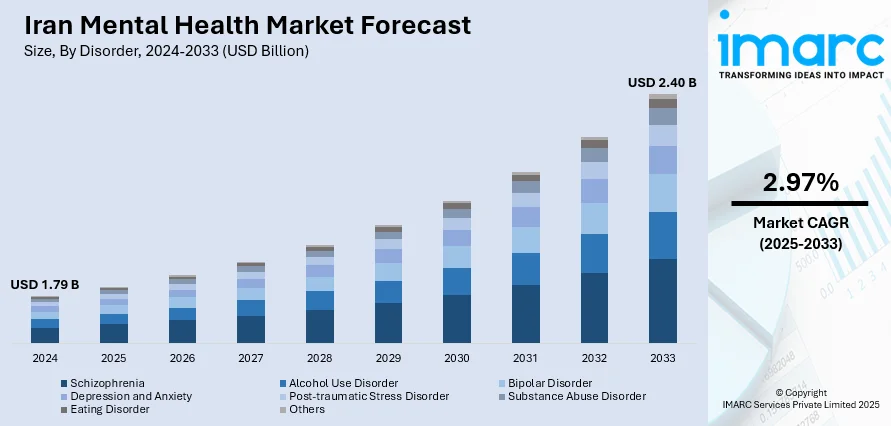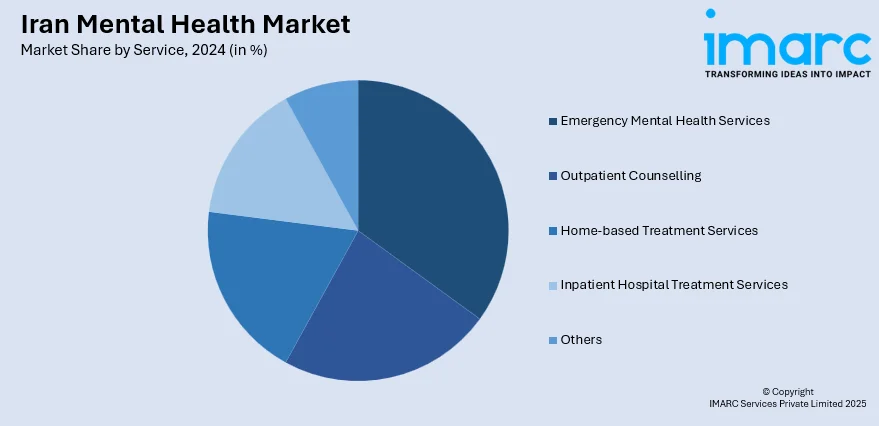
Iran Mental Health Market Size, Share, Trends and Forecast by Disorder, Service, Age Group, and Region, 2025-2033
Iran Mental Health Market Overview:
The Iran mental health market size reached USD 1.79 Billion in 2024. The market is projected to reach USD 2.40 Billion by 2033, exhibiting a growth rate (CAGR) of 2.97% during 2025-2033. The market is driven by the growing incidence of mental health diseases; high unemployment and inflation, which have the effect of boosting stress and anxiety levels within the population. Government's initiatives to increase mental health services, such as the creation of national counseling hotlines and community-based programs, help to facilitate greater access and lower stigma for help-seeking, which all have a beneficial effect on the Iran mental health market share dynamics.
|
Report Attribute
|
Key Statistics
|
|---|---|
|
Base Year
|
2024 |
|
Forecast Years
|
2025-2033
|
|
Historical Years
|
2019-2024
|
| Market Size in 2024 | USD 1.79 Billion |
| Market Forecast in 2033 | USD 2.40 Billion |
| Market Growth Rate 2025-2033 | 2.97% |
Iran Mental Health Market Trends:
Integration of Primary Healthcare with Mental Health Services
Particularly in rural areas, Iran has made significant strides in incorporating mental health services within its primary healthcare system. Iran's mental health strategy has been built on the integration of mental health services within basic healthcare since 1988. Training general practitioners and community health workers, known as "Behvarzes," to provide basic mental health care is part of integration. The approach aims to reduce stigma, promote early intervention, and improve access to mental health care. Despite the program's effectiveness in rural regions, metropolitan areas have difficulties, especially in underserved populations where infrastructure and resources are limited. The escalating urbanization and migration patterns call for further changing and scaling up these services to provide equal mental health services in the nation.

To get more information on this market, Request Sample
Rise of Digital Mental Health Platforms
The expansion of digital technologies has opened new channels for mental health assistance in Iran. According to the Iranian Organization for Psychology and Counseling, as of October 2023, more than one-third of the population suffers from psychiatric disorders, which is higher than the average age worldwide. With almost half of recorded instances involving individuals under 30, suicide rates are also on the rise. Although independent sources indicate the number is substantially higher, a police official recently estimated the annual number of suicides at 4,000. Hence, telemedicine and digital therapy websites have come in as good options compared to conventional face-to-face sessions, and they are more accessible, particularly for people living in remote areas. These websites present the possibility of seeking assistance secretly, which is important in a world where mental illness is stigmatized. The application of mobile technology in monitoring and managing mental health has also been well accepted, especially by the youth, which further contributes to the Iran mental health market growth.
Socio-Cultural Factors Affecting Mental Health Perception
In Iran, socio-cultural factors directly influence the perception and intervention of mental health conditions. Family lives and social networks frequently provide immediate support, with persons depending on intimate relationships in overcoming mental health issues. However, social norms and traditional religious beliefs may also contribute to the stigma associated with mental health issues, preventing some people from seeking professional help. Influencers in the community and religious leaders can have a significant impact on changing attitudes and encouraging candid discussions about mental health. By utilizing such social institutions, mental health interventions can be made more effective and foster an environment of greater support for those with mental health challenges.
Iran Mental Health Market Segmentation:
IMARC Group provides an analysis of the key trends in each segment of the market, along with forecasts at the country and regional levels for 2025-2033. Our report has categorized the market based on disorder, service, and age group.
Disorder Insights:
- Schizophrenia
- Alcohol Use Disorder
- Bipolar Disorder
- Depression and Anxiety
- Post-traumatic Stress Disorder
- Substance Abuse Disorder
- Eating Disorder
- Others
The report has provided a detailed breakup and analysis of the market based on the disorder. This includes schizophrenia, alcohol use disorder, bipolar disorder, depression and anxiety, post-traumatic stress disorder, substance abuse disorder, eating disorder, and others.
Service Insights:

- Emergency Mental Health Services
- Outpatient Counselling
- Home-based Treatment Services
- Inpatient Hospital Treatment Services
- Others
A detailed breakup and analysis of the market based on the service has also been provided in the report. This includes emergency mental health services, outpatient counselling, home-based treatment services, inpatient hospital treatment services, and others.
Age Group Insights:
- Pediatric
- Adult
- Geriatric
A detailed breakup and analysis of the market based on the age group has also been provided in the report. This includes pediatric, adult, and geriatric.
Region Insights:
- Tehran
- Khuzestan
- Bushehr
- Esfahan
- Khorasan
- Others
The report has also provided a comprehensive analysis of all the major country markets, which include Tehran, Khuzestan, Bushehr, Esfahan, Khorasan, and others.
Competitive Landscape:
The market research report has also provided a comprehensive analysis of the competitive landscape. Competitive analysis such as market structure, key player positioning, top winning strategies, competitive dashboard, and company evaluation quadrant has been covered in the report. Also, detailed profiles of all major companies have been provided.
Iran Mental Health Market Report Coverage:
| Report Features | Details |
|---|---|
| Base Year of the Analysis | 2024 |
| Historical Period | 2019-2024 |
| Forecast Period | 2025-2033 |
| Units | Billion USD |
| Scope of the Report |
Exploration of Historical Trends and Market Outlook, Industry Catalysts and Challenges, Segment-Wise Historical and Future Market Assessment:
|
| Disorders Covered | Schizophrenia, Alcohol Use Disorder, Bipolar Disorder, Depression and Anxiety, Post-Traumatic Stress Disorder, Substance Abuse Disorder, Eating Disorder, Others |
| Services Covered | Emergency Mental Health Services, Outpatient Counselling, Home-Based Treatment Services, Inpatient Hospital Treatment Services, Others |
| Age Groups Covered | Pediatric, Adult, Geriatric |
| Regions Covered | Tehran, Khuzestan, Bushehr, Esfahan, Khorasan, Others |
| Customization Scope | 10% Free Customization |
| Post-Sale Analyst Support | 10-12 Weeks |
| Delivery Format | PDF and Excel through Email (We can also provide the editable version of the report in PPT/Word format on special request) |
Key Questions Answered in This Report:
- How has the Iran mental health market performed so far and how will it perform in the coming years?
- What is the breakup of the Iran mental health market on the basis of disorder?
- What is the breakup of the Iran mental health market on the basis of service?
- What is the breakup of the Iran mental health market on the basis of age group?
- What is the breakup of the Iran mental health market on the basis of region?
- What are the various stages in the value chain of the Iran mental health market?
- What are the key driving factors and challenges in the Iran mental health market?
- What is the structure of the Iran mental health market and who are the key players?
- What is the degree of competition in the Iran mental health market?
Key Benefits for Stakeholders:
- IMARC’s industry report offers a comprehensive quantitative analysis of various market segments, historical and current market trends, market forecasts, and dynamics of the Iran mental health market from 2019-2033.
- The research report provides the latest information on the market drivers, challenges, and opportunities in the Iran mental health market.
- Porter's five forces analysis assist stakeholders in assessing the impact of new entrants, competitive rivalry, supplier power, buyer power, and the threat of substitution. It helps stakeholders to analyze the level of competition within the Iran mental health industry and its attractiveness.
- Competitive landscape allows stakeholders to understand their competitive environment and provides an insight into the current positions of key players in the market.
Need more help?
- Speak to our experienced analysts for insights on the current market scenarios.
- Include additional segments and countries to customize the report as per your requirement.
- Gain an unparalleled competitive advantage in your domain by understanding how to utilize the report and positively impacting your operations and revenue.
- For further assistance, please connect with our analysts.
 Request Customization
Request Customization
 Speak to an Analyst
Speak to an Analyst
 Request Brochure
Request Brochure
 Inquire Before Buying
Inquire Before Buying




.webp)




.webp)












